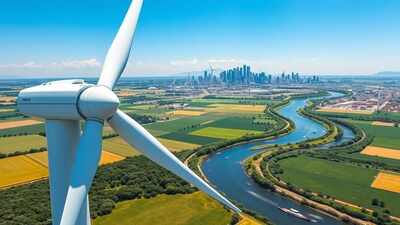India’s Wind Energy: Leading a Sustainable Future
Celebrating Global Wind Day 2025

On Global Wind Day 2025, Union Minister for New and Renewable Energy, Pralhad Joshi, spoke about the importance of wind energy. He said wind energy is vital for India’s clean energy plans. It also plays a key role in India’s goal to become a global manufacturing hub.
Wind Energy: The Core of India’s Renewable Plan
At a meeting in Bengaluru, Joshi stressed that India needs dependable energy. This energy can come from wind, solar, or other sources. It is crucial for India to become a global manufacturing leader.
He stated, “Wind energy is not just part of our renewable energy plan. It is at the very core of it and central to Atma Nirbhar Bharat.”
India’s Wind Energy Success
India has made great strides in wind energy:
- India’s wind capacity has reached 51.5 GW.
- This is a 150% increase over the last ten years.
- India now exports turbines and parts worldwide.
India aims for 100 GW of wind energy by 2030. This includes 30 GW from offshore projects. Strong policy changes and a robust manufacturing system support these goals.
Ambitious Goals for a Greener Future
India has set clear and bold goals:
- 50% of its power from non-fossil fuels by 2030.
- Net-zero emissions by 2070.
Joshi emphasized that wind energy is key to building an Atma Nirbhar Bharat. He also outlined three challenges the sector must address:
- Combining wind with solar and storage for 24/7 power.
- Lowering tariffs from the current Rs 3.90 per unit.
- Improving manufacturing efficiency to compete globally.
Vision for Renewable Energy
Highlighting PM Modi’s vision, Joshi said the aim is to use renewable energy to power India’s manufacturing sector. Traditional energy will continue to meet household needs.
India is now the world’s fourth-largest country in installed wind power capacity. It is also the third-largest renewable energy producer. India’s manufacturing capacity is growing and will keep rising.
“No one thought India would become the third-largest manufacturer of renewable energy in 10 years, but today it is a reality,” said the minister.
Unleashing the Full Power of Wind Energy
To fully harness the wind sector, Joshi outlined five key areas:
- Expanding into new states like Madhya Pradesh, Telangana, and Odisha.
- Starting the offshore wind sector with leasing areas in Gujarat and Tamil Nadu.
- Integrating wind with storage for reliable green power.
- Modernizing the grid using AI-based forecasting.
- Strengthening local manufacturing across the wind value chain.
Important Reports and Recognitions
Joshi released two key reports:
- Wind Energy Roadmap
- Manufacturing Roadmap
These documents show India’s strategic vision and strong resolve. They aim to build a robust, self-reliant wind ecosystem.
The event also recognized top-performing states in wind capacity addition:
- Karnataka led with 1,331.48 MW.
- Tamil Nadu followed with 1,136.37 MW.
- Gujarat with 954.76 MW.
Union Minister of State for New and Renewable Energy, Shripad Yesso Naik, and Karnataka’s Energy Minister, KG George, were also present.
Global Climate Promises
India’s wind ambitions match its global climate promises. These include the five-point ‘Panchamrit’ pledge made at COP26 in Glasgow:
- Reaching 500 GW of non-fossil capacity by 2030.
- Cutting emissions by 1 billion tonnes by 2030.
- Reducing emissions intensity by 45% by 2030.



